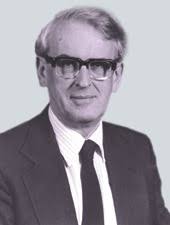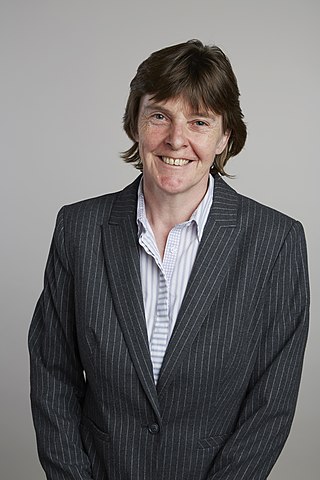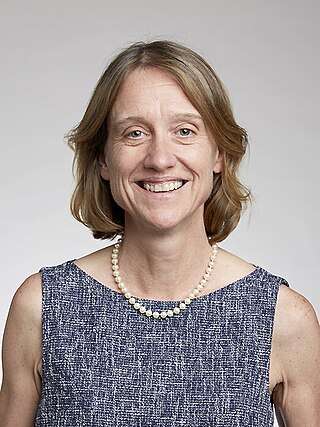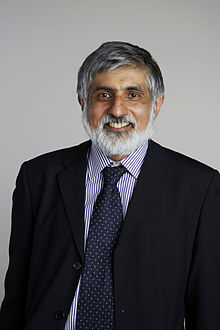
Sir Walter Fred Bodmer is a German-born British human geneticist.
Christopher Miles Perrins, is Emeritus Fellow of the Edward Grey Institute of Field Ornithology at the University of Oxford, Emeritus Fellow at Wolfson College, Oxford and Her Majesty's Warden of the Swans since 1993.

David Chilton Phillips, Baron Phillips of Ellesmere was a pioneering, British structural biologist and an influential figure in science and government.

Dame Kay Elizabeth Davies is a British geneticist. She is Dr Lee's Professor of Anatomy at the University of Oxford and a Fellow of Hertford College, Oxford. She is director of the Medical Research Council (MRC) functional genetics unit, a governor of the Wellcome Trust, a director of the Oxford Centre for Gene Function, and a patron and Senior Member of Oxford University Scientific Society. Her research group has an international reputation for work on Duchenne muscular dystrophy (DMD). In the 1980s, she developed a test which allowed for the screening of foetuses whose mothers have a high risk of carrying DMD.
Philip Christopher England FRS is a British geophysicist and former Chair of Geology at the Department of Earth Sciences, University of Oxford, whose research centres upon the evolution, deformation and metamorphism of mountain ranges and the development of island arcs. He has widely used applied mathematics to model mountain building, proving that they behave as extremely viscous fluids.
Sir Marc Feldmann,, is an Australian-educated British immunologist. He is a professor at the University of Oxford and a senior research fellow at Somerville College, Oxford.

Santiago Schnell FRSB FRSC is a renowned scientist and academic leader, currently serving as the William K. Warren Foundation Dean of the College of Science at the University of Notre Dame, as well as a professor in the Department of Biological Sciences, and Department of Applied and Computational Mathematics and Statistics. He is an internationally recognized expert in theoretical and mathematical biology, as well as biophysical chemistry. Schnell's multidisciplinary vision and commitment to collaboration among various fields have earned him a reputation as an innovative scientist and forward-thinking academic administrator.
James Dickson Murray FRSE FRS, is professor emeritus of applied mathematics at University of Washington and University of Oxford. He is best known for his authoritative and extensive work entitled Mathematical Biology.
Philip Candelas, is a British physicist and mathematician. After 20 years at the University of Texas at Austin, he served as Rouse Ball Professor of Mathematics at the University of Oxford until 2020 and is a Fellow of Wadham College, Oxford.
Simon Tavaré is the founding Director of the Herbert and Florence Irving Institute of Cancer Dynamics at Columbia University. Prior to joining Columbia, he was Director of the Cancer Research UK Cambridge Institute, Professor of Cancer Research at the Department of Oncology and Professor in the Department of Applied Mathematics and Theoretical Physics (DAMTP) at the University of Cambridge.

Alison Mary Etheridge is Professor of Probability and Head of the Department of Statistics, University of Oxford. Etheridge is a fellow of Magdalen College, Oxford.

Michael A. Häusser FRS FMedSci is professor of Neuroscience, based in the Wolfson Institute for Biomedical Research at University College London (UCL).

Benjamin Guy Davis is Professor of Chemical biology in the Department of Pharmacology and a member of the Faculty in the Department of Chemistry at the University of Oxford and a Fellow of Pembroke College, Oxford. He holds the role of Science Director for Next Generation Chemistry (2019-2024) at the Rosalind Franklin Institute.

(Edith) Yvonne Jones is director of the Cancer Research UK Receptor Structure Research Group at the University of Oxford and a Fellow of Jesus College, Oxford. She is widely known for her research on the molecular biology of cell surface receptors and signalling complexes.

Julia Alison Noble is a British engineer. She has been Technikos Professor of Biomedical Engineering at the University of Oxford and a fellow of St Hilda's College since 2011, and Associate Head of the Mathematical, Physical and Life Sciences Division at the university. As of 2017, she is the chief technology officer of Intelligent Ultrasound Limited, an Oxford spin-off in medical imaging that she cofounded. She was director of the Oxford Institute of Biomedical Engineering (IBME) from 2012 to 2016.In 2023 she became the Foreign Secretary of The Royal Society.
Ruth Elizabeth Baker is a British applied mathematician and mathematical biologist at the University of Oxford whose research interests include pattern formation, morphogenesis, and the mathematical modeling of cell biology and developmental biology.
Judy Hirst is a British scientist specialising in mitochondrial biology. She is Director of the MRC Mitochondrial Biology Unit at the University of Cambridge.

Richard A. Dixon is distinguished research professor at the University of North Texas, a faculty fellow of the Hagler Institute of Advanced Study and Timothy C. Hall-Heep distinguished faculty chair at Texas A&M University.
Helen M. Byrne is a mathematician based at the University of Oxford. She is Professor of Mathematical Biology in the university's Mathematical Institute and a Professorial Fellow in Mathematics at Keble College. Her work involves developing mathematical models to describe biomedical systems including tumours. She was awarded the 2019 Society for Mathematical Biology Leah Edelstein-Keshet Prize for exceptional scientific achievements and for mentoring other scientists and was appointed a Fellow of the Society in 2021.

Irene Miguel-Aliaga is a Spanish-British physiologist who is Professor of Genetics and Physiology at Imperial College London. Her research investigates the plasticity of adult organs, and why certain organs change shape in response to environmental changes. She was elected Fellow of the Royal Society in 2022.











